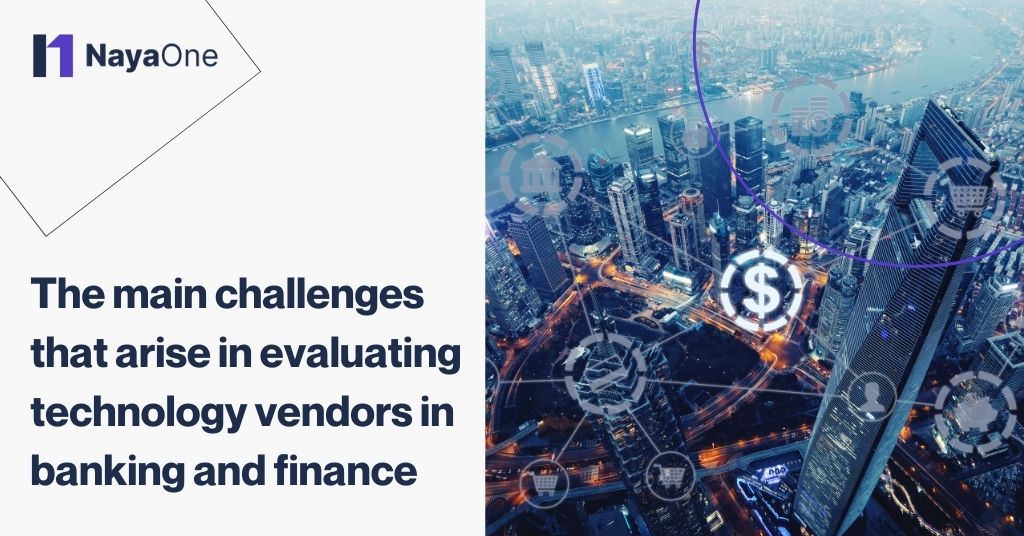Technology plays a pivotal role in transforming the banking and finance sector, enabling institutions to enhance operational efficiency, improve customer experience, and maintain a competitive edge. From AI-driven insights to advanced cybersecurity measures, innovative technology solutions help financial institutions stay agile and compliant in a rapidly evolving market.
Evaluating technology vendors is critical for ensuring that the solutions implemented meet the organisation’s specific needs, regulatory requirements, and future growth goals. Proper evaluation allows institutions to select vendors that offer the most advanced features, security measures, and integration capabilities, reducing the risk of costly disruptions.
Interestingly, 56% of B2B buyers explore new technology vendors because they offer more feature-rich solutions than their current providers. This underscores the importance of product capabilities in vendor selection, making it vital for banks and finance firms to carefully assess whether new technologies provide the competitive edge they seek.
In this blog post, you can expect to learn key strategies for assessing vendor capabilities, understanding the importance of compliance, and identifying which technological solutions align with their business objectives.
How can you identify and understand vendor requirements?
When selecting technology vendors in the banking and finance sector, it’s essential to understand how their offerings align with your bank’s and finance firms’ specific requirements. This involves not only identifying your unique operational needs but also ensuring that any vendor meets the strict regulatory standards governing the industry. By focusing on these two critical aspects—business needs analysis and regulatory compliance—you can effectively navigate the vendor selection process with confidence.
Business needs assessment
The initial step in the technology vendor selection process involves identifying and articulating the specific technological requirements of your organisation. Begin with a comprehensive evaluation of your existing workflows, challenges, and strategic objectives. Involve stakeholders from different departments to gain insights into their difficulties and explore how technology can bridge those gaps.
Essential inquiries to consider include:
- What are the primary operational inefficiencies we face?
- In what ways can technology facilitate or automate our processes?
- What level of scalability is necessary to accommodate our growth?
- Which features are essential for enhancing customer satisfaction or bolstering security?
Once these requirements are articulated, they will form the basis for assessing vendor solutions. Ensuring that vendor capabilities align with your organisational goals is vital for selecting a solution that promotes sustainable success.
Compliance with regulations
In the banking and finance industry, technology vendors must adhere to regulatory standards. Financial institutions are governed by stringent regulations designed to protect customer information, ensure financial soundness, and uphold market integrity.
When assessing potential vendors, it is essential to confirm their compliance with applicable regulations, such as:
- GDPR (General Data Protection Regulation) for data privacy.
- PCI DSS (Payment Card Industry Data Security Standard) for secure payment processing.
- AML (Anti-Money Laundering) and KYC (Know Your Customer) regulations to prevent fraud.
Technology vendors must provide documentation that verifies their compliance with these standards and demonstrate that security and compliance measures are integrated into their offerings. Ensuring regulatory compliance minimises risk and fosters trust among stakeholders and customers.
Assessing technology vendors in alignment with your business goals and regulatory requirements guarantees the selection of solutions that improve efficiency and foster innovation while maintaining compliance and security for your institution. By thoroughly understanding your needs and prioritising compliance, you can make well-informed choices that promote enduring success in the contemporary technology-oriented financial environment.

How can vendor capabilities be assessed?
The selection of an appropriate technology vendor for bank and finance firms necessitates a comprehensive and meticulous evaluation process, which frequently extends over several months.
Given that merely 7% of purchasers finalise a technology acquisition in less than a month, it is evident that the majority of B2B organisations adopt a prudent strategy when assessing potential technology vendors.
Important considerations include the compatibility of the vendor’s technology with existing systems and the scalability of the solution to accommodate future growth. These elements are crucial in ensuring that the technology investment not only fulfils current requirements but also aligns with long-term business goals.
Technical fit
Evaluating the technical fit of a vendor’s technology is crucial to ensuring seamless integration with your bank and finance firm’s existing infrastructure. Start by assessing whether the technology is compatible with your current systems, including hardware, software, and any third-party applications you rely on. Consider how much customisation is required, the ease of integration, and the level of support the vendor provides for implementation.
Additionally, check if the vendor offers APIs, cloud-based options, or other features that enable smooth interoperability. A solution that fits well technically will help avoid disruptions, reduce downtime, and minimise the costs associated with complex integrations.
Scalability and flexibility
In addition to the technical fit, the scalability and flexibility of a vendor’s solution are key to future-proofing your technology investments. Evaluate whether the technology can grow alongside your business, handling increased workloads, users, or data volumes without a significant overhaul.
Flexibility is equally important; consider how easily the solution can adapt to changes in your business environment, whether through feature upgrades, new modules, or integration with emerging technologies. A solution that can scale and evolve ensures your organisation stays competitive and agile as market demands shift.
Evaluating a vendor’s capabilities requires a comprehensive analysis rather than a superficial review. It is essential to confirm that the technology integrates seamlessly with existing systems and possesses the scalability and flexibility necessary to accommodate future requirements. By prioritising these considerations, bank and finance firms can make technology investments that are not only beneficial in the immediate term but also equipped to facilitate sustained growth and adaptation over time.
What is the importance of security and risk management?
Security and risk management are paramount when evaluating technology vendors. As financial institutions handle vast amounts of sensitive data, ensuring robust security measures and minimising potential risks is essential to safeguard the organisation and its customers. A thorough assessment of a vendor’s approach to data protection and risk mitigation will help prevent costly breaches and ensure operational stability.
Data protection
Security and risk management are paramount when evaluating technology vendors. As financial institutions handle vast amounts of sensitive data, ensuring robust security measures and minimising potential risks is essential to safeguard the organisation and its customers. A thorough assessment of a vendor’s approach to data protection and risk mitigation will help prevent costly breaches and ensure operational stability.
Risk mitigation
Evaluating the risks associated with a vendor’s technology is crucial to ensuring that your organisation can anticipate and manage potential challenges. Begin by assessing the vendor’s history of security incidents or breaches and how effectively they’ve managed those situations. Review the vendor’s risk management practices, including regular audits, vulnerability assessments, and business continuity plans. It’s also important to consider the potential impact of vendor failure—whether due to financial instability or technical shortcomings—on your operations. Choose a vendor with comprehensive contingency plans, service-level agreements (SLAs), and support systems to mitigate the risk of service disruptions and other critical failures.
How can vendor reputation and reliability be assessed?
In the competitive business landscape of B2B technology procurement, the reputation and dependability of a vendor are pivotal factors in the decision-making process. 52% of buyers depend on software comparison platforms and a considerable number place their trust in product review websites, it is evident that brand recognition and trust significantly impact vendor selection. Assessing a vendor’s history is vital to confirm that you are collaborating with a provider who is both reputable and consistently dependable in delivering high-quality solutions.
Track record
Assessing a vendor’s history of performance and reliability involves scrutinising their past engagements and evaluating their reputation in the financial sector. Begin by researching case studies, client testimonials, and references from other financial institutions to gauge their effectiveness and satisfaction levels. Analyse any historical data on their service performance, including uptime records, incident response times, and their ability to meet contractual obligations. Additionally, consider the vendor’s longevity in the market and their track record for innovation and adapting to industry changes. Technology vendors with a solid performance history and positive feedback from reputable sources can offer greater confidence in their reliability and the quality of their technology.
Vendor reputation and reliability are integral to making informed technology purchasing decisions. By leveraging trusted sources such as software comparison websites and product review sites, and by thoroughly assessing a vendor’s track record, financial institutions can select partners who are not only recognised and trusted but also proven to deliver consistent and high-quality results. This approach ensures that your technology investments are both secure and aligned with your strategic goals.
How can you evaluate cost and value analysis?
Cost and value analysis are pivotal in the B2B technology procurement process, with 40% of buyers indicating that cost significantly influences their purchasing decisions. Notably, 11% of buyers find the cost to be “hugely” important in their choices, highlighting the critical role pricing plays. Beyond the initial price, it is essential to evaluate the total cost of ownership and the value proposition of the technology. This comprehensive assessment ensures that organisations make cost-effective decisions while securing solutions that offer substantial long-term benefits.
Total cost of ownership
In the assessment of technology solutions, it is crucial to take into account the total cost of ownership (TCO), which extends beyond the initial acquisition cost. It is important to analyse ongoing expenses such as maintenance, support, and updates, as these can greatly influence the overall financial outlay. Furthermore, it is vital to uncover any potential hidden costs, including implementation charges, training fees, and integration difficulties. A thorough evaluation of TCO aids in preventing unexpected expenses and offers a more comprehensive understanding of the financial obligations associated with the technology throughout its lifecycle. This method ensures that your organisation is equipped to handle all related costs and can effectively plan its budget for both present and future requirements.
Value proposition
The value proposition of a technology solution refers to the advantages and ROI it provides in terms of its associated costs. It is essential to assess how the technology meets the specific needs of your organisation, enhances operational efficiency, and improves overall performance. Metrics such as productivity improvements, cost reductions, and increased customer satisfaction should be considered to evaluate the ROI. By comparing these advantages against the total costs, one can determine whether the investment is worthwhile. A compelling value proposition illustrates that the technology not only fulfils immediate needs but also supports long-term strategic objectives and yields significant returns on its expenses.
Cost and value analysis are pivotal in making informed technology purchasing decisions. By thoroughly evaluating the total cost of ownership and weighing the technology’s value proposition against its costs, bank and finance firms can ensure that their investments are both financially viable and strategically advantageous. This approach helps in selecting solutions that offer the best balance between affordability and long-term benefits, ultimately supporting sustained organisational success.
How can you work around integration and support with technology vendors?
Integration and support are crucial factors in the technology procurement process, with 90% of B2B buyers agreeing that a vendor’s ability to integrate seamlessly with existing systems significantly impacts their decision. Ensuring that new technology integrates smoothly with your current infrastructure and assessing the quality of support and service levels provided by the vendor can greatly influence the success of your technology investment. Understanding these aspects helps to select solutions that not only fit well with your existing systems but also provide reliable ongoing support.
Ease of integration
It is crucial to comprehend the ease with which a vendor’s technology can be integrated into your existing systems to ensure seamless deployment and operational effectiveness. Assess the technology’s compatibility with your current infrastructure, which includes hardware, software, and any third-party applications. Investigate the integration methods offered by the vendor, such as APIs, middleware, or cloud solutions. Take into account the degree of customisation needed and its potential effects on your current workflows. A technology that integrates effortlessly minimises disruptions, shortens implementation timelines, and boosts overall productivity.
Quality of support and service agreements
Evaluating the standard of customer support and service level agreements (SLAs) is vital for guaranteeing that you receive necessary assistance when challenges occur. Examine the vendor’s support services, including response times, the availability of support channels (such as phone, email, or chat), and the qualifications of their support personnel. Analyse the SLAs provided to grasp the assurances regarding service uptime, issue resolution, and maintenance. Dependable support and transparent service commitments ensure that any technical difficulties are resolved swiftly, thereby minimising downtime and preserving operational continuity.
By thoroughly assessing how well new technology fits with your existing systems and the level of support provided, you can ensure a smooth transition and reliable ongoing service. This comprehensive evaluation helps in making informed choices that support seamless operations and long-term success.
Is it important to assess innovation and future-proofing with technology vendors?
Selecting a vendor committed to technological advancements and adaptability is essential for future-proofing your organisation’s investments. As technological trends and industry standards continue to evolve, it’s crucial to consider how a vendor’s commitment to innovation and their ability to adapt to future changes will impact your long-term success. Ensuring that your technology partner is forward-thinking and flexible can significantly enhance your organisation’s ability to stay competitive and responsive to new opportunities.
Technological progress
When assessing a vendor, it is essential to evaluate their dedication to technological progress and innovation. Examine their history of implementing new features, enhancing existing products, and committing resources to research and development. Take into account their strategic plan for future product improvements and whether their technology is in line with emerging trends such as artificial intelligence, blockchain, or cloud computing. A vendor that emphasises innovation can deliver solutions that not only satisfy current demands but also evolve to meet future challenges, enabling bank and finance firms to remain competitive and capitalise on new opportunities as they emerge.
Flexibility
It is vital to assess a vendor’s capacity to adjust to future industry developments and technological innovations for sustained success. Evaluate how responsive the vendor is to changes in technology and market requirements. Seek evidence of their ability to adapt to new standards, regulations, and technological advancements. Consider their methodology regarding updates and upgrades, as well as whether they provide scalable solutions that can grow alongside your organisation’s expanding needs. A vendor that showcases flexibility can offer a more robust and future-ready solution, ensuring that your technology stays pertinent and effective as the industry evolves.
As technology and industry standards evolve, selecting a vendor that is committed to innovation and adaptable to future changes is essential. By focusing on a vendor’s track record of technological advancements and their ability to respond to industry shifts, you ensure that your technology investments remain relevant and effective over time. This forward-thinking approach helps your organisation stay competitive and prepared for emerging opportunities, ultimately supporting sustained growth and success.
Get in touch with NayaOne to overcome challenges when choosing a technology vendor
Choosing the right technology vendor is crucial in the ever-evolving landscape of financial technology. At NayaOne, we understand the challenges you face and offer a unique solution through our secure sandbox environment.
By leveraging our curated marketplace and rigorous evaluation process, we help you identify and implement the best fintech solutions tailored to your needs. Partner with us to navigate vendor complexities and ensure that your financial technology investments drive maximum value and innovation for your organisation.
FAQs
To verify a vendor’s reliability, start by requesting and reviewing references from their existing clients to gain insights into their performance and reliability. Look for case studies or success stories that demonstrate their experience in your industry or with similar challenges. Verify any industry-specific certifications or compliance standards they claim to hold, as these can indicate their adherence to necessary regulations. Additionally, read independent reviews on software comparison sites to get an unbiased perspective on their technology and services.
To ensure a technology vendor aligns with your business goals, start by making sure their technology meets your specific business needs. Evaluate whether their solutions are scalable to accommodate your business’s growth over time. Check if the technology can be customised to fit your processes and requirements. Finally, assess their willingness to collaborate and understand your strategic goals to ensure that their solutions will support your long-term objectives.
Customer feedback plays a significant role in evaluating a technology vendor as it provides real-world insights into the vendor’s performance and reliability. Reading reviews and testimonials from other users can highlight both strengths and potential issues with the technology and the vendor’s support services. Customer feedback can reveal how effectively the vendor addresses problems, the quality of their customer service, and the overall user experience. This information is valuable in making an informed decision and avoiding potential pitfalls.





